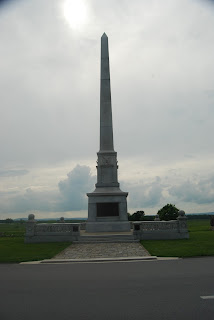Time was getting short and it was almost beer O'clock by the time we finished at the Peach Orchard, so we drove along Plum Run but didn't stop there, before heading on to the Pennsylvania Monument where we decided to miss out Spanglers Spring and Culps Hill before heading on to the Angle.
This is the Pennsylvania Memorial, a very imposing structure.
And again.
Statues of Meade and Lincoln.
Lady in period dress (on the left - don't think dayglo had been invented in 1863).
The Pennsylvania Memorial, if I remember correctly it records the names of all Pennsylvania citizens who fought in the battle.
A Minnesota Regt memorial on the union lines in front of the Pennsylvania Memorial.
Monuments marking the union line on Cemetary Ridge.
Can't remember what this one commemorates but it's on the union lines.
Looking south along the union lines on Cemetary Ridge, the Pennsylvania Memorial in the distance.
Looking north along the union lines, the Copse of Trees is on the right.
A panoramic view looking west from Cemetary Ridge, the trees in the distance are those on Seminary Ridge that covered the initial forming up of the confederate assault forces for Picket's charge. Note the undulations in the ground that at least provided some respite from grazing fire, but not much. The Codori Farm is visible in the middle of the picture and the Appalachian Mountains can be seen in the far distance.
The Army of the Potomac Memorial.
The Copse of Trees, looking north. The union lines were facing to the left, on the left hand edge of this photograph. The confederate troops that made it to the union lines crossed the low stone wall, only to find that three union regiments had wheeled back to fire enfilade into their flanks. The union regimental positions are marked by the three posts with rectangular plaques in front of the trees.
The Copse of Trees looking south. Survivors of the charge that made it across the wall were faced with three union regiments in line, volley firing towards the camera.
The Highwater Mark of the confederacy.
And again.
And once more.
Union battery positions and the union artillery park.
The memorial marking the approximate position of Armistead's mortal wounding. His fall took the heart out of the remaining confederate troops who fell back, effectively ending the battle.
Looking west, the Angle is an almost right hand turn to the left in front of the memorial by the tree.
71st Pennsylvanian infantry memorial at the Angle.
Looking south from the Angle.
Memorial to a Zouave Regt, close to the Copse of Trees.
The Highwater Mark again.
The line of union memorials behind the Copse of Trees.
An unusual motif for a New York unit, with a North American indian and a wigwam. This is the memorial to the 42nd New York infantry.
We finished up with a visit to the Soldiers Cemetry. This is the memorial close to the site of Lincoln's Gettysburg Address, delivered at the inauguration of the Soldiers Cemetary.
The Soldier's National Monument.
Not much of a headstone, but better than the "unknown" next to him. Considering many of the dead were left on the ground or in shallow graves for the best part of a year after, it's better than nothing, but contrasts with the grand monuments elsewhere onthe battlefield.
Quite a lot of them though.
So, that's where we ended our tour. The Appalachian Brewery bar and restaurant on the outskirts of Gettysburg was calling. On the whole well worth seeing if the chance ever presents itself. 150 years ago this July 1st, 2nd and 3rd.
Thanks for looking.












































































